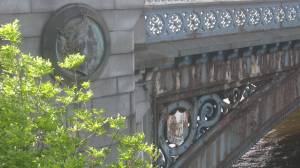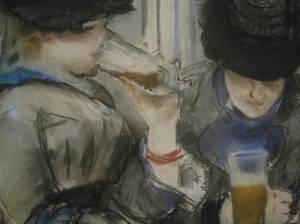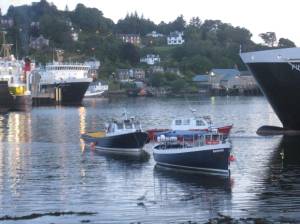I apologize for being incommunicado for a while. Since we left York our wireless access has been minimal, and the times where we have been able to locate a hot spot the connection has been weak. Needless to say this has been frustrating, but I think about how travel and travel writing used to be accomplished back in the days of The Grand Tour, without netbooks, Blackberrys or cell phones – completely off the grid, because none existed. Our fellow travelers from the bygone era had pen and paper and no electronic distractions. So I have gone back to this simple but effective way of memorializing thought and adventure, just writing it down now for editing and publishing purposes later (albeit, writing in this case with the help of Microsoft Word.) The stories will always be there, but hidden from view for a bit longer than anticipated. I do have some more posts on England that I have yet to publish – one on the university city of Durham and the other on Haworth, where the Brontes lived and wrote – and Steve has his first blog post to cobble from the copious notes he has taken (on missed trains, packing fiascos, and pub culture), but those will have to wait as I need to tell you all about Scotland. What a magical country this is! Mountains and lochs and white sandy beaches. Rolling hills, lush glens, highland and lowlands with ruined castles, standing stones and cairns dotted about. Haggis, malt whisky, marmalade and shortbread. And unrivaled Highland hospitality. Our first week in Scotland has been incredible. Too much to reveal here so I will give you the highlights – and there have been many. And we’ve only just begun. Our first stop: Glasgow.
Glasgow – The city of Glasgow gets a bad rap. Sooty, depressed, crime-ridden, no interesting or distinct architecture, building or landmark – this image from the 60s and 70s persists to this day but it is an inaccurate description of the modern Glasgow. It is interesting, parts of it quite pretty, with exciting cafes, restaurants and pubs, several phenomenal museums, an impressive cathedral, and benefits from its location on the River Clyde. I will say, however, that this city is one of the few cities I have been to that looks and feels completely different when the sun is shining. Under cloud cover it is a bustling modern city with potential, but nothing exceptional to speak of. With the sunshine, everything gleams, including the few sooty parts that are left, and it is easy to see its greatness, and its quirkiness. George Square is one example of Glasgow’s greatness, as it is a majestic yet approachable plaza with some Parisian touches in the buildings and cafes that surround it. Yet, it is Scottish and I loved walking through it.
I had to meet Steve in Glasgow as he was coming up from Peterborough where he stayed the night after having attended the Cambridge Beer Festival with some mates he met the first time he went to the festival two years ago. In Glasgow we stayed at the Babbity Bowster, a pub that has a few rooms for guests on its top floor, which we remembered fondly as a solid carrier of local ales and top-notch Scottish fare the last time we were here. The food was still good, but the ales were a bit uninspired, save for the Kelburn, a locally brewed tipple, which was tasty and fresh. They did have plenty of mass-produced watery lagers which the Scots can’t seem to get enough of (I mean Fosters. Really??) What was also interesting to note in the pubs is that Scotland is apparently not under the same stringent weights and measures rules as their neighbor to the south. The same goes for the price of a drink, which was surprisingly expensive. For example, in England, a half pint of ale or lager is exactly half the price of a full pint. Exactly. In Glasgow, it was not half but more than. And the full pints themselves were pricy, usually around 3.50 pounds (however in New York City terms, this isn’t so bad.) Factor in the exchange rate and you are looking at an expensive round.
Another one of our haunts from our last visit to Glasgow is The Horseshoe, a pub with reputedly the longest continuous bar in the UK. The pub gets its name from its horseshoe-shaped bar and is popular with the locals as it was packed every night we were there. It is also the place where I was introduced to my new favorite drink, the Ginger Grouse. One part Famous Grouse blended whisky, two parts ginger beer, it is gooood. While getting happily acquainted with the new love of my drinking life and Steve with one of the many malts on offer, we met a cast of Glaswegian punters, who were hilarious when we understood what they were saying (Glaswegians are notorious for having the most unintelligible accent in Scotland. This is not an overstatement. Their speech is a fast guttural mumble and at times I thought they were speaking to me in garbled Gaelic peppered with German or Dutch or even Swedish.) Another new favorite pub is the Bon Accord, in the West End, which had the best local ales that we had seen. Steve and I were so comfortable at the bar chatting to the bartenders that we lost track of time, almost missing dinner, but were able to try every cask ale they had.
On our list of things to do were St. Mungo’s Cathedral, built in the 12th century and a survivor of the Reformation; the Necropolis, the crowded cemetery containing the remains of Glasgow’s denizens, perched on a hill overlooking High Street; Provend’s Lordship, built in 1471 and the oldest house in Glasgow; and the Burrell Collection, a fantastic museum containing the fruits of shipping magnate William Burrell’s obsessive collecting over most of his life. Burrell gifted his collection to the city in 1944 with the caveat that it be housed at least 16 miles outside the city center. It took the trustees 23 years to find the appropriate location, but only serendipitously when the Pollack Estate was willed to Glasgow. What I love to see at the Burrell (it’s pronounced, BU-rrell, not bu-RELL, as the taxi driver pointed out while at the same time making fun of us on our first visit here) are the collection of stained glass windows from churches all over Europe and the 17th century rooms with the dark wood paneling and gorgeous furniture, particularly the long great hall tables made of heavy dark wood and festooned with simple but elegant carvings on their legs (I secretly covet these and imagine having one in my home someday.)
A new discovery for us in the city was the bridge walk. Glasgow has 21 bridges over the Clyde and each one looks different. Some are painted in bright colors while others are mini-suspension bridges glowing in silver. Crossing these bridges was a good way to navigate the forgotten southern bank which appeared to house a series of pretty university buildings. We saw many people jogging over the bridges and then back again, a nice way to get in one’s exercise. After three days in Glasgow, we made our way to our next stop, and a new city for us: Oban.
Oban – When planning this journey we had not intended on going to Oban, the major port city in Argyll, and the home of its namesake malt whisky. However, plans changed when we learned that our friends Sara and Keir from the States would be visiting Keir’s father, aunt and uncle in Oban the same time we were in Scotland. Dougie and Mary, Keir’s funny, proud and charming uncle and aunt, kindly and graciously put us up at their lovely and comfortable home in Kilmore, just south of Oban. After an idyllic three-and-a-half hour train ride from Glasgow, passing sparkling lochs, emerald green paddocks with wooly sheep and tiny lambs, we were picked up at the train station by Diarmid, Keir’s father, and then promptly taken to see the ruins of Dunstaffanage Castle, an old MacDougall fort built in the 1200s.
On the way to, at and from the castle, Diarmid gave us a history lesson on the powerful Clan Campbell (from which he is descended,) and the Dukes of Argyll (the heads of Clan Campbell) and just about every battle they fought, castle they built, community they planned and land they took over. For centuries, the Campbells ran the show in this part of Scotland and remnants of their time in history can still be seen. We were finally conveyed to Dougie and Mary’s where we were treated to afternoon tea, gin and tonics and an incredible dinner of locally caught salmon. Mary is a phenomenal cook and it was nice and a bit awe-inspiring to watch her whip up delicious meals and do it so effortlessly. She has a vegetable and herb garden on the property which is surrounded by azaleas, chandelier flowers and plum trees, and uses what she grows in her cooking. At dinner, among the topics of discussion at the festive table were the Campbells (again), the English Civil War, the Jacobite Rebellion, the Corryvrechan (the name of Dougie and Mary’s charter boat which has since been sold) and Mrs. Tiggle-Winkle. Yes, Beatrix Potter’s Mrs. Tiggle-Winkle made an appearance when Mary read the children’s story to us after dinner, prompted to do so when Sara revealed she had never heard of it (Shame on you, Sara ;))
There are number of extant ancient sites in Argyll and when you ponder it, it does give you goose bumps. On the patch of land next door which Dougie and Mary also own are two burial mounds, one from 5,000 years ago and the other a mere baby at 4,000 years old. We were able to walk atop these mounds and marvel at their existence, wondering who these people who created them were. Once Queen Victoria made going to Scotland fashionable, the Victorians came here in droves, some of them pillaging the burial mounds for jewels and other artifacts. Today you can still see where they disturbed the earth and moved the stone slabs sitting on the peaks. Continuing this journey into ancient times, Keir and Sara along with Keir’s cousin James took us to Dunadd, an Iron Age fort which used to be surrounded by the sea but today by the River Add. It is historically significant for it was where the royal seat of Dalriada was established by King Fergus from Ireland in 500 A.D. But, more importantly, it was where I was proclaimed queen. On the huge rock atop the knoll are several carvings, one an outline of a boar which you can barely see, the others a hollowed out basin and a footprint. It is believed that the basin and footprint were used as part of coronation ceremony by the kings of Dalriada. Since I was the only one in our group whose foot fit in the hollowed out footprint (granted Sara was wearing oversized wellies, but that’s beside the point), I was naturally declared queen and my subjects commanded to swear fealty to me and my reign. Long live the queen!
After two days with the Campbell-Lindsay clan it was back to Oban for a couple of days while we planned our next move. Oban is very pretty and we enjoyed walking the esplanade where we could easily view the port, the houses perched on the cliffs overlooking the Firth of Lorn and McCaig’s Tower, an amphitheatre built during the turn of the 20th century by out-of-work stone masons. It was never completed (apparently Mr. McCaig wanted to add a museum, an art gallery, a chapel, a central tower and bronze statues of his family members but died before work could be undertaken), and so today we just have its shell to enjoy and, if you are 16 or 17 years old, a place to sneak off to drink and smoke after hours.
Because Oban is the gateway to the Isles, namely Mull, Kerrera, Lismore and Islay, it is packed with tourists, many of them clueless, and the roads are saturated with right-hand-side-of-the-road drivers attempting to navigate driving on the left. In Oban we stayed at a cute B&B called the Kilchrenan House, recommended by Dougie, which served a hearty and delicious breakfast of porridge plus the egg dish of your choice between the ungenerous almost-hour of 8-8:45 (groan.) The Kilchrenan was our base from which to research the next steps of The Grand Tour. Our intention was to go to the Isle of Mull, a 40-minute ferry trip from Oban, and then to Iona, a small island off the southwest coast of Mull, where St. Columba established a monastery here in the 6th century and proceeded to spread Christianity throughout Scotland and northern England. Since Mull is easily accessible from Oban, and word is out about its beauty, it was impossible to locate available accommodation. For hours and with sanguine Internet connections, Steve canvassed hotels, B&Bs, self-catering cottages, bunk houses, campsites – nothing was available. It seemed as though every human being in Oban was making his or her way to Mull. Not content with returning to Glasgow, we decided to try for a neighboring isle – Lismore, Coll, Tiree, Jura, Arran, Islay, anywhere on the Western Isles – and it was Islay that won out. We secured the only thing available to us on Islay: a five-bedroom, five-bathroom ranch house with two fireplaces, (each with the requisite set of stag antlers lurking above), washer/dryer, dishwasher, large dining and living rooms, and a long verandah overlooking the Laggan River just two miles east of the town of Bowmore. So it was on this isle of malts where we spent the next nine days in comfort and solitude.
A separate post on Islay is forthcoming. It is so incredible that it deserves to stand alone.












Thanks for another terrific post on your travel!!
Hello Emma.
You have been in America too long. An Australian would have pronounced Burrell with the accent on the first syllable.
As Queen of Dalriada you should have been a powerful figure. The Scots from Ireland who founded Dalriada were Gaels and the Gaelic language that became most common in the country before English domination was brought with them. They did well to establish a kingdom when there were Vikings to the north, Picts to the east, Angles to the south-east and Britons to the south-west. The Roman term for the people in Hibernia (Ireland)was Scotti, so it must have been the dominance of the Scots in Caledonia that resulted in the land becoming known as Scotland.